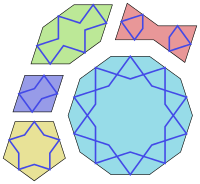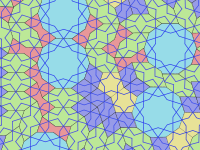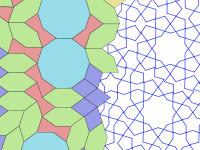Girih tiles



Girih tiles[pronunciation?] are a set of five tiles that were used in the creation of tiling patterns for decoration of buildings in Islamic architecture. They are known to have been used since about the year 1200 and their arrangements found significant improvement starting with the Darb-i Imam shrine in Isfahan in Iran built in 1453.
The five shapes of the tiles are:
- a regular decagon with ten interior angles of 144°;
- an elongated (irregular convex) hexagon with interior angles of 72°, 144°, 144°, 72°, 144°, 144°;
- a bow tie (non-convex hexagon) with interior angles of 72°, 72°, 216°, 72°, 72°, 216°;
- a rhombus with interior angles of 72°, 108°, 72°, 108°; and
- a regular pentagon with five interior angles of 108°.
All sides of these figures have the same length; and all their angles are multiples of 36° (π/5 radians). All of them, except the pentagon, have bilateral (reflection) symmetry through two perpendicular lines. Some have additional symmetries. Specifically, the decagon has tenfold rotational symmetry (rotation by 36°); and the pentagon has fivefold rotational symmetry (rotation by 72°).
Girih are lines (strapwork) which decorate the tiles. The tiles are used to form girih patterns, from the Persian word گره, meaning "knot".[1] In most cases, only the girih (and other minor decorations like flowers) are visible rather than the boundaries of the tiles themselves. The girih are piece-wise straight lines which cross the boundaries of the tiles at the center of an edge at 54° (3π/10) to the edge. Two intersecting girih cross each edge of a tile. Most tiles have a unique pattern of girih inside the tile which are continuous and follow the symmetry of the tile. However, the decagon has two possible girih patterns one of which has only fivefold rather than tenfold rotational symmetry.
Mathematics of girih tilings
In 2007, the physicists Peter J. Lu and Paul J. Steinhardt suggested that girih tilings possessed properties consistent with self-similar fractal quasicrystalline tilings such as Penrose tilings, predating them by five centuries.[2][3]
This finding was supported both by analysis of patterns on surviving structures, and by examination of 15th century Persian scrolls. However, we have no indication of how much more the architects may have known about the mathematics involved. It is generally believed that such designs were constructed by drafting zigzag outlines with only a straightedge and a compass. Templates found on scrolls such as the 97 foot (29.5 metres) long Topkapi Scroll may have been consulted. Found in the Topkapi Palace in Istanbul, the administrative center of the Ottoman Empire and believed to date from the late 15th century, the scroll shows a succession of two- and three- dimensional geometric patterns. There is no text, but there is a grid pattern and color-coding used to highlight symmetries and distinguish three-dimensional projections. Drawings such as shown on this scroll would have served as pattern-books for the artisans who fabricated the tiles, and the shapes of the girih tiles dictated how they could be combined into large patterns. In this way, craftsmen could make highly complex designs without resorting to mathematics and without necessarily understanding their underlying principles.[4]
This use of repeating patterns created from a limited number of geometric shapes available to craftsmen of the day is similar to the practice of contemporary European Gothic artisans. Designers of both styles were concerned with using their inventories of geometrical shapes to create the maximum diversity of forms. This demanded a skill and practice very different from mathematics.[4]
Examples
- Different patterns
-
Complex girih patterns with 16-, 10- and 8-point stars at different scales in ceiling of the Tomb of Hafez in Shiraz, 1935
-
A window of the crown prince's apartment in the Topkapı Palace, Istanbul, Turkey, with 6-point stars; the surrounds have floral arabesque tiling
-
Interior archway at the opening of the Sultan’s Lodge in the Ottoman Green Mosque in Bursa, Turkey (1424), with 10-point stars and pentagons
See also
- Aperiodic tiling
- Penrose tiling
- Roger Burrows, author of coloring books based on Girih tiling
- Zellige
References
- ^ Sebastian R. Prange (September–October 2009). "The Tiles of Infinity". Saudi Aramco World: 24–31.
- ^ Peter J. Lu and Paul J. Steinhardt (2007). "Decagonal and Quasi-crystalline Tilings in Medieval Islamic Architecture" (PDF). Science. 315 (5815): 1106–1110. Bibcode:2007Sci...315.1106L. doi:10.1126/science.1135491. PMID 17322056.
- ^ Supplemental figures
- ^ a b Gulru Necipoglu (1995). The Topkapi Scroll: Geometry and Ornament in Islamic Architecture. Getty Research Institute.
External links
- Girih Tiles and Islamic Geometric Designs in Modern Architecture
- Browser based Girih tiling editor
- John Savard's reconstructions
- "Medieval Islamic architecture presages 20th century mathematics". Harvard University Gazette. 2007-02-22. Retrieved 2007-03-14.
- "Medieval Islamic tiling reveals mathematical savvy". New Scientist. 2007-02-22. Retrieved 2007-03-14.





